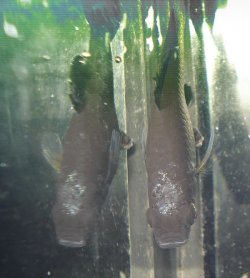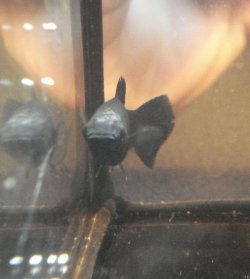Hi!
I have a black molly female with a white spot on the head. Right now doesn't show anything but that spot.
Two weeks ago the male died. He has become very weak, sometimes swimming backwords, didn't eat, and had equilibrum problems (in the last day). He had also white spots on his body, he held down his fins almost all the time. Also the fins looked bad.
Three weeks ago a male guppy died, I only saw suspicious that his tail fin was affected (at that time I suspected my male betta)
I attach close shot picture to help you. It was quite hard to make it...

My fishtank has 150L and my buddies are:
2 Blue Gouramy
3 Black Molly females
3 Bettas (1 male)
8 Zebra Danio
I started the tank 1.5 month ago.
If you recognize this disease please advise. I would like to take action but I don't know what to do.
Thanks.
I have a black molly female with a white spot on the head. Right now doesn't show anything but that spot.
Two weeks ago the male died. He has become very weak, sometimes swimming backwords, didn't eat, and had equilibrum problems (in the last day). He had also white spots on his body, he held down his fins almost all the time. Also the fins looked bad.
Three weeks ago a male guppy died, I only saw suspicious that his tail fin was affected (at that time I suspected my male betta)
I attach close shot picture to help you. It was quite hard to make it...

My fishtank has 150L and my buddies are:
2 Blue Gouramy
3 Black Molly females
3 Bettas (1 male)
8 Zebra Danio
I started the tank 1.5 month ago.
If you recognize this disease please advise. I would like to take action but I don't know what to do.
Thanks.




 Maybe it will be helpfull for somebody.....who knows.
Maybe it will be helpfull for somebody.....who knows.